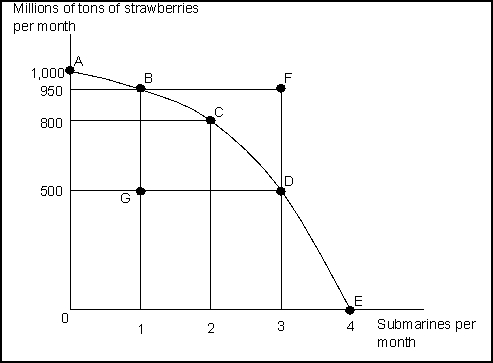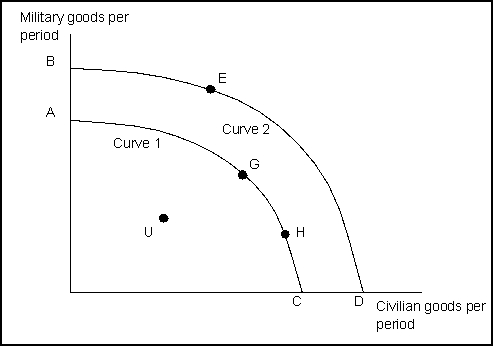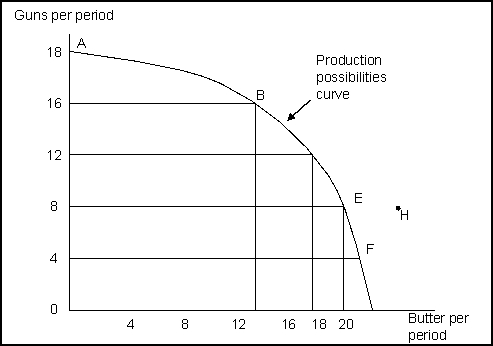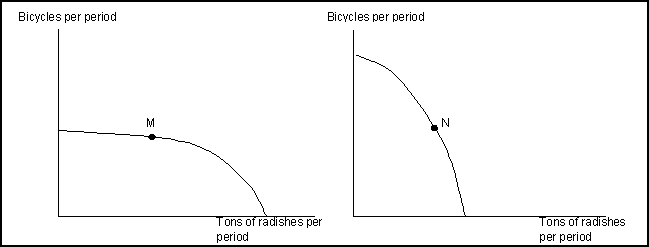A) money, labor, natural resources, and capital.
B) technology, human capital, and natural resources.
C) money, capital, and natural resources.
D) labor, capital, and natural resources.
Correct Answer

verified
Correct Answer
verified
Multiple Choice
If an economy is producing a combination of goods that places it inside the production possibilities curve, then it has:
A) economic growth.
B) full employment.
C) efficiency.
D) idle factors of production or inefficient use of resources.
Correct Answer

verified
Correct Answer
verified
Multiple Choice
Use the following to answer questions  -(Exhibit: Strawberries and Submarines) Suppose the economy is now operating at pointC.Achieving production at point F would require:
-(Exhibit: Strawberries and Submarines) Suppose the economy is now operating at pointC.Achieving production at point F would require:
A) that the economy achieve full employment and an efficient allocation of resources.
B) that the economy reduce its production of strawberries.
C) that the economy reduce its production of submarines.
D) that the economy improve its technology or increase the quantities of factors of production it has.
Correct Answer

verified
Correct Answer
verified
Multiple Choice
Use the following to answer questions
 -(Exhibit: Production Possibilities Curve-Military and Civilian Goods) A movement from point G to point U could be a representation of what happened during:
-(Exhibit: Production Possibilities Curve-Military and Civilian Goods) A movement from point G to point U could be a representation of what happened during:
A) World War II.
B) the Great Depression.
C) the postwar expansion following World War II.
D) a period of rapid economic growth.
Correct Answer

verified
Correct Answer
verified
Multiple Choice
In a command socialist economy:
A) resources are government owned but individuals make some decisions over their use.
B) resources are government owned and government exercises broad power over their use.
C) resources are privately owned and individuals make decisions over their use.
D) resources are privately owned but government exercises broad power over their use.
Correct Answer

verified
Correct Answer
verified
Multiple Choice
If an economy's factors of production were owned by the government sector and the coordinating activity was done by a government planning board, the economy would be called:
A) capitalism.
B) market capitalism.
C) command socialism.
D) mixed capitalism.
Correct Answer

verified
Correct Answer
verified
Multiple Choice
Increasing the level of education in the United States will:
A) shift the production possibilities curve to the left.
B) improve the level of technology.
C) lead to increased natural resource use.
D) lead to workers possessing greater human capital.
Correct Answer

verified
Correct Answer
verified
Multiple Choice
In a market capitalist economy, which of the following is not an accepted role for government?
A) provision of national defense
B) enforcing a legal system
C) establishing policies to encourage full employment
D) All of the above are acceptable roles for government.
Correct Answer

verified
Correct Answer
verified
Multiple Choice
Specialization arises because
A) some people don't like doing some tasks.
B) differences in the costs of production give some producers a comparative advantage in the production of particular goods or services.
C) the government directs resources into certain activities.
D) inefficient production forces producers to trade.
Correct Answer

verified
Correct Answer
verified
Multiple Choice
The set of acquired skills and abilities that workers bring to the production of goods and services is:
A) money.
B) wealth.
C) human capital.
D) natural ability.
Correct Answer

verified
Correct Answer
verified
Multiple Choice
An economy is said to have a comparative advantage in the production of a good if it can:
A) produce that good with more resources than another economy.
B) produce that good with a higher opportunity cost than another economy.
C) produce that good outside its production possibilities curve.
D) produce the good at a lower opportunity cost than another economy.
Correct Answer

verified
Correct Answer
verified
Multiple Choice
Technological improvements will:
A) leave the production possibilities curve unchanged.
B) shift the production possibilities curve inward.
C) shift the production possibilities curve to outward.
D) necessarily lead to increased unemployment.
Correct Answer

verified
Correct Answer
verified
True/False
The production possibilities curve shows various combinations of two products that an economy can produce when there is full employment and economic efficiency.
Correct Answer

verified
Correct Answer
verified
Multiple Choice
In market capitalism:
A) factors of production are privately owned and decisions are made privately.
B) factors of production are owned by the government but decisions are made privately.
C) there is no role for government.
D) the consumer has few choices to make.
Correct Answer

verified
Correct Answer
verified
Multiple Choice
Use the following to answer questions :
 -(Exhibit: Guns and Butter) Points A, B, E, and F:
-(Exhibit: Guns and Butter) Points A, B, E, and F:
A) indicate combinations of guns and butter that society can produce using all of its factors efficiently.
B) show that the opportunity cost of more guns increases, but that of more butter decreases as more of each good is produced..
C) indicate that society wants butter more than guns.
D) indicate constant costs for guns and increasing costs for butter.
Correct Answer

verified
Correct Answer
verified
Multiple Choice
Knowledge that can be applied to the production of goods and services is:
A) natural resources.
B) specialization.
C) technology.
D) comparative advantage.
Correct Answer

verified
Correct Answer
verified
Multiple Choice
Human capital is:
A) the set of acquired skills and abilities that workers bring to the production of goods and services.
B) the financial wealth the economy has available to produce goods and services.
C) the ability to produce one of two goods at relatively lower cost.
D) a factor of production only if it occurs naturally.
Correct Answer

verified
Correct Answer
verified
Multiple Choice
The role of government in shifting the production possibilities curve to the right is considered:
A) supporting economic growth.
B) redistributing income.
C) providing certain goods and services.
D) enforcing private property rights.
Correct Answer

verified
Correct Answer
verified
Multiple Choice
Use the following to answer questions  -(Exhibit: Bicycles and Radishes 1) The exhibit shows production possibilities curves for two countries that produce only radishes and bicycles.The axes of both graphs are measured in equivalent units.Country A is now operating at point M, and Country B is now operating at point N.The opportunity cost of producing an additional ton of radishes would be greater in:
-(Exhibit: Bicycles and Radishes 1) The exhibit shows production possibilities curves for two countries that produce only radishes and bicycles.The axes of both graphs are measured in equivalent units.Country A is now operating at point M, and Country B is now operating at point N.The opportunity cost of producing an additional ton of radishes would be greater in:
A) Country A.
B) Country B.
C) neither; the opportunity cost would be the same in both countries.
D) there is not enough information given to answer the question.
Correct Answer

verified
Correct Answer
verified
Multiple Choice
The three broad types of factors of production are:
A) capital, labor, and natural resources.
B) money, profit, and interest.
C) stocks, bonds, and financial assets.
D) technology, human capital, and comparative advantage.
Correct Answer

verified
Correct Answer
verified
Showing 101 - 120 of 193
Related Exams